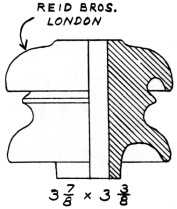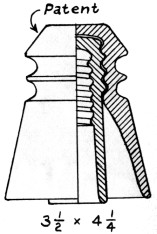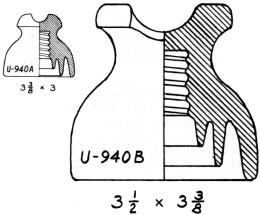Porcelain Insulator News
by Jack H. Tod
Reprinted from "INSULATORS - Crown Jewels of the Wire", July 1978, page 26
Dear Jack:
A man sold these two insulators to my father in England last month,
saying that they were excavated from a circa-1920 dump. Any info would be
appreciated.
The pin type has an insert which screws out, and this insert is
fluted up the sides and over its top for insertion of a wire. Both the insert
and outer shell are glazed white except for the three threaded surfaces which
are unglazed.
Mike Doyle
Annandale, Va.

- - - - - - - - -
Dear Mike:
I can't give you any specific info on your English insulators,
since I'm unfamiliar with foreign manufacturers and their products. The
double-skirted item (at top) is a common form of shackle insulator much the same as ones made in the U.S. up to current tines. These are for use in
dead-ending circuits with a shackle mount on the pole or crossarm.

The pin type
appears to be a form of "dry-spot" insulator, and an interesting one at
that. One lead of the bridle-wire pair would be afforded a dry spot on its
insulation by running it up over the center insert in the groove provided for
it. It would require two of these insulators on the crossarm to dry-spot both
wires of the bridle pair. Although there is a U.S. patent on the British "screw-cap" form of
dry-spot insulator, I am not aware of any U.S. patent on
this particular style you have. I have no easy way to research the English
patents.
Jack

Dear Jack:
I just traded some glass for a U-940A Imperial plus another triple-petticoat
Imperial which I think is an addition to the Universal Style Chart. (See U-940B
drawing above.)
Except for the extra petticoat, this one appears to be essentially identical
to the No.3 Imperial shown on page 22 of the 1902 C. S. Knowles catalog (Frank
Peters reprint).
This specimen has a white glaze and is a skirt-rest. It has three handstamp
markings as follows: The "crown" trademark marking, the
"MANUFACTURED BY ... " marking with "PROCELAIN"
error, and a 9-7-98 date. Do you think it merits a new U- number?
David Bethman
Bellingham, Wash.
- - - - - - - - - -
Dear David:
Yes, this should be added to the Style Chart, and it will be U-940B. Whereas
things such as variations in exact crown style or groove widths are real ho-hum
situations on modern cable styles, they are important on these early
items by Fred Locke, Thomas and Imperial. We want to be able to refer to each
specific style (and state of evolution) that was made in the very early days of
porcelain pin types. (The above U-940B drawing was made from shadow profile and
measured dimensions subsequently sent by David at my request.)
Jack

Dear Jack:
Must be about time to write a few lines. Have several interesting
items.
First is this Illinois marking. Haven't access here to many Illinois
"map" markings, but this one has the state reversed from all the
others, both incuse and underglaze types. Is this an error?

Secondly -- I have, since collecting started, found most of the Victor
Insulators, Inc. insulators in only chocolate brown and with the usual markings
as in your books. Recently I acquired a half dozen different U- numbers, each
with a mottled brown glaze and each one differing widely in coloring -- from
rose red mahogany to ochre-brown to "closest to red" brick shade. All
have this uncharacteristic incuse marking (above) Note the logo is more nearly
square, has rounded corners, a very thick V with a flat instead of pointed
bottom. I am wondering if this might be the earliest of the V-I markings and if
these are therefore very early V-I production insulators. The varied glazes sure
spruced up that corner of the collection.

Lastly -- I had never seen the U-514 until I bought a collection last fall.
There were a dozen in a box, all with the metal pins in and in the case upside
down. There are five very distinctly different varieties, but all are similar in
that they have the same elongated petticoat as the U-514. These are:
- CHANCE (u-g), exactly as the U-514 chocolate brown.
- V-I (incuse), exactly like U-518 but with 1" petticoat extension,
chocolate brown.
- THOMAS (incuse), exactly like U-511 but with 1-1/8" petticoat
extension, chocolate brawn.
- KNOX (r-e), like U-511 but with 1" petticoat extension, sky
glaze.
- KNOX (r-e), more like U-512 but with 1" petticoat extension, bright orangey
chocolate brown.
This sure is an interesting group. Did the extended petticoat make them a
special-use insulator?
Also added recently a white U-259 Fred Locke, a U-939 Fred Locke, a U-928A,
and the U-928 with embossed marking "BOCH'S INSULATOR PAT. APL'D.
FOR".
Really using your new book, too (Electrical Porcelain). A great reference
& needed. Good luck at the National.
Lew Hohn,
Rochester, N.Y.
- - - - - - - - -
Dear Lew:
Very sorry, old buddy, but I'm giving you a "D" in geography for
turning your Illinois maps on one side or the other to cause the Mississippi
River to flow in an east-west direction. The Illinois "map" trademark
is as shown here -- and usually appears on specimens correctly oriented. It's
not the map which is reversed; it is the number inside it which is.

I have a number of the old marking stamps used to apply markings on Illinois
insulators, including the one used for this specific marking. Both the map
outline and the year number (1934 in this case) are glued to the rubber backing
of the stamp. Installed through the center of the map and the padded backing is
a small channel for insertion of the various catalog numbers (237 here) for
making runs of their various insulator styles. Although there was obviously a
"normal" manner for inserting these type numerals on a day-to-day
basis, they could naturally be inserted either way. Most specimens have the
bottom of the catalog numbers at the left side of the map, or at least the ones
I've noticed were mostly that way.
Re your V-I insulators, I completely agree with your assessment that these
are probably the earliest production in the 1935-1953 span of the company. Most
companies quit making the pretty mahogany-type glazes in the 1930's and went to
the chocolate brown (the current standard along with sky glaze). I can't recall
ever having had or seen many brown V-I insulators other than chocolate brown
Yours are certainly unusual in that respect, not to mention the variety of
marking.
I would also have agreed with you that your group of insulators with very
extended petticoats such as on the U-514 were made for special applications
and/or certain customers. The U-514 drawing in the Style Chart was from a
chocolate brown CHANCE Specimen I found in the Parkersburg factory dump some
years ago. When visiting the KNOX plant several years ago, they were making a
run of these insulator styles (with sky glaze), but these had sanded holes
instead of threads. The Knox president-manager told me at the time that these
were "equipment insulators", so I didn't inquire further then. I had
never heard of any other collector specimens of these styles until receiving
your report.
Of course, knowing the answer to your question is better than guessing, so I
wrote to A. B. Chance Co. about it. They sent back information which proved we
guessed correctly.
Chance did make these, and it was a special order for Consolidated Edison
N.Y. They apparently quoted on these as early as 1958 but believed the first
order was probably in 1962, which agrees with the 5-2-62 date of the factory
drawing. Their files indicate that Knox was their big competitor on this
particular item.
The Chance drawing SPO-3915 is titled "steel shank insulator", and
it is an assembly of the threaded pin type (U-514) with a cemented-in steel
shank with machine thread end (5/8-11 threads), washer and nuts. Overall height
from end of the shank to top of the insulator ears is 10-1/2".
The insulator itself is part number 350081 with brown glaze, 350082 with
white glaze.
I presume all your specimens have cemented-in steel shanks. Further, I'm
guessing your CHANCE ones had threaded holes and that your KNOX ones had sanded
holes instead.
It's a moot point whether the U-514 should be in the Universal Style Chart if
it was furnished only with cemented-in pins. As yea have already found, the
U-514 reference is very handy for describing these distinctively different pin
types when you encounter them.
Lew, I think anyone who latches on to four more very rare items (the F. Locke
& Boch items) in one season is guilty of hoggin' the trough. Please move
over a bit and let some of the other boys have a chance!
Jack
| 